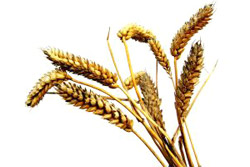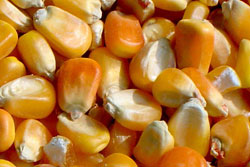What are grains?
Grains, also called cereal or cereal grains, are the seeds of grasses (gramineae). A typical grain consists of the testa, the aleuronic layer, the embryo and the endosperm. The embryo is the living part of the grain, and is very rich in nutrients. Most nutrients (e.g. protein, vitamins and minerals) are concentrated in the aleuronic layer, whilst the endosperm consists mainly of starch.
With the advent of agriculture in the early history of human civilisation, grain consumption became prominent, especially in developing countries. Grains constitute a major source of energy in most households today, and occupy the base of food pyramids. Examples of grains are wheat, maize, rice, barley oats, millet and sorghum.
Nutritional value of grains
Grains and grain products are important sources of energy, carbohydrate, protein and fibre.
Though grains generally lack vitamins A, C and B12, they contain a range of micronutrients such as vitamin E, some of the B vitamins (for example B6), magnesium and zinc. The bioavailability of the B-vitamins, however, appears to be low. For example, the bioavailability of B6 from grains tends to be low, whereas bioavailability of B6 from animal products is generally quite high.
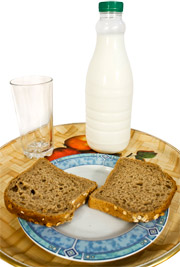
Ideally, calcium and phosphorus occur in the ratio of 1:1. However, grains have a low calcium/phosphorus ratio, which can negatively impact bone growth and metabolism. This is because consumption of an excess of dietary phosphorus when calcium intake is inadequate or low is reported to result in secondary hyperparathyroidism and progressive bone loss.
The high phytate content of whole grain grains may reduce the availability of calcium for absorption because the phytate forms insoluble complexes with calcium. The combined effect of low calcium content, a low Ca/P ratio, and low bioavailability of calcium via high phytate content may pose problems for healthy bone development in populations that use grains as a staple food. It has in fact been reported that in populations where grains provide the major source of calories, osteomalacia, rickets and osteoporosis are common, even when there is sufficient sunshine to prevent vitamin D deficiency.
The high phytate content of grains also affects the bioavailability of non-haem iron. A number of factors including phytate and fibre, tannins, lectins and phosphate may contribute to the inhibition of non-haem iron absorption. The high levels of phytate contribute most to the inhibition of non-haeme iron. To eliminate its inhibitory effect on non-haem iron absorption, phytate must be almost totally removed.
Some studies of zinc absorption in rats and humans have clearly demonstrated that consumption of phytate contained in whole grain grains (for example, wheat, rye, barley, oats) inhibits zinc absorption. The bioavailability of zinc from meat is four times greater than that from grains, and it implies that total dependence on grain- and plant-based diets (for example, vegetarian diets) may lead to impaired zinc metabolism in developed countries including Australia.
Grain protein is usually incomplete as it lacks some amino acids. In particular, lysine is limited in grains that form the basis for many diets. Furthermore, the essential amino acid, threonine, tends to be lower in grain-based proteins compared to animal protein sources.
Whole grain foods such as wheat, rice, oats, and barley are relatively low in energy density and are reported to help maintain energy balance.
What effect does processing have on grains?
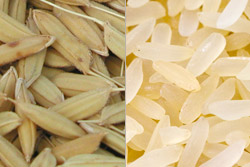
-
Make them digestible;
-
Inactivate natural toxins and prevent bacterial growth and food spoilage;
-
Improve the appearance, taste and texture of foods;
-
Improve convenience to meet consumer demand for quick and easy meal solutions;
-
Maximise their nutritional value.
Processing can make it easier for nutrients from grains to be digested or for nutrients to be added (fortification). There are a number of factors that determine the quality of grains and pulses for human consumption. For example, milling affects the nutritional value of grains in two ways:
-
The physical separation of the different grain components drastically reduces the nutrient content of the grain; and
-
Grinding reduces the particle size, which impacts on the glycaemic index and resistant starch content of the grain.
Before grains are consumed, they must undergo some form of processing. The methods of processing grains (e.g. milling) reduces the nutritional value of grains. Generally, the final nutrient content of a grain will depend on the extent to which the outer layers are removed during processing (extraction rate). Removal of these outer layers implies loss of fibre, vitamins and minerals. Highly milled grains such as white maize flour, polished rice and white wheat flour are therefore of less nutritive value because they have lost most of the germ and outer layers and with them most of the B vitamins and some of the protein and minerals.
The extraction rate is the number of parts by weight of flour that is produced from 100 parts of the grain (e.g. wheat). The higher the extraction rate, the more bran is included in the wheat flour and hence the higher the amount of dietary fibre, vitamins and minerals in the flour. Flours can be produced to a range of different extraction rates, depending upon the amount of bran, germ and pericarp that is removed. Flours of high extraction rates retain many more of the micro-nutrients than those of lower extraction rates. The disadvantages of low-extraction flours to the consumer are that they contain less B vitamins, minerals, protein and fibre than high-extraction flours.
Grains feature prominently in most breakfast cereals, bread and pasta. As a result of losses that occur during the processing of grains, those used as breakfast cereals are often enriched.
Can grains be bad for nutrition?
Grains constitute a biologically novel food for mankind, but questions remain unanswered as to whether they are particularly suitable for the genetic constitution of humans. It has been realised since the early 1950s (with the discovery of wheat gluten as the causative agent in coeliac disease) that grain peptides interact with and induce change in human physiology, and therefore elicit disease and dysfunction. Grains contain a variety of secondary metabolites which tend to be either toxic or anti-nutritional.
Alkylresorcinols are phenolic compounds which are reported to be in the highest amounts in rye (97 mg/100 g), in high amounts in wheat (67 mg/100 g) and in lower amounts in other grains such as oats, barley, millet and corn.
The traditional role of these compounds is to provide resistance from pathogenic organisms during dormancy and germination. Though alkylresorcinols pose problems in animal feeding, their relevance in human nutrition is unclear. In particular, giving large amounts of rye to cattle, sheep, horses, pigs and poultry has been shown to cause slower growth than feeding of other grains.
Alpha-amylase inhibitors are found in wheat, rye, barley, oats, rice and sorghum. By virtue of their resistance to heat, alpha-amylase inhibitors persist through bread baking and are therefore found in large amounts in bread, breakfast grains, pasta and other wheat products.
The acute effects of alpha-amylase inhibitors therefore appear to have therapeutic benefit in patients suffering from diabetes mellitus, obesity and other diseases of insulin resistance, though chronic administration in animal models has been shown to induce deleterious histological changes to the pancreas and pancreatic hypertrophy. In view of the potential adverse effects these dietary anti-nutrients can have on human health, it is advisable to be cautious with alpha-amylase inhibitors in human foodstuffs.
Protease inhibitors have been found in most grains. Protease inhibitors are proteins which have the ability to inhibit the proteolytic activity of certain enzymes and are common throughout the plant kingdom, particularly among the legumes. As with alpha-amylase inhibitors, there are a multiplicity of plant proteins which have protease inhibitor activity.
Two examples of protease inhibitors are the Kunitz inhibitor, which has a specificity directed mainly towards trypsin in human gastric juice; and the Bowman-Birk inhibitor, which is capable of inhibiting chymotrypsin as well as trypsin. The Bowman-Birk inhibitor is relatively stable to both heat and digestion and can therefore pass through cooking and the stomach with little change.
There are no known dietary effects of chronic low level exposure to plant protease inhibitors in humans. If anything, there is some evidence to suggest they may have beneficial, anti-neoplastic effects.
Lectins are proteins that have a strong affinity for carbohydrate-containing molecules, particularly toward the sugar component. They have the ability to bind to specific glycoconjugate receptors on the surface of the erythrocyte cell membranes and are recognised as the major anti-nutrient of food. Lectins, especially wheat germ agglutinin, (WGA) bind surface glycans on gut brush border epithelial cells, which leads to impairment in digestive/absorptive activities, stimulates shifts in bacterial flora and modulates the immune state of the gut.
Lectin activity has been demonstrated in wheat, rye, barley, oats, corn, and rice but not in sorghum or millet.
How are grains good for your health?
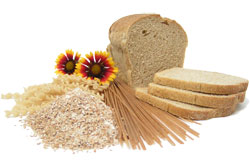
There is no strong evidence for an association between fibre consumption and cancer; therefore, it is highly recommended that high-fibre foods, such as legumes and whole grain breads, grains, rice, and pasta, be consumed.
Summary
Grains lack a number of nutrients which are essential for human health and well-being. Furthermore, grains contain anti-nutritional factors (phytates, alkylresorcinols, protease inhibitors, lectins, etc) which are not well tolerated and in most cases tend to be health risks in humans. Of more concern is the ability of grain proteins (protease inhibitors, lectins, opioids and storage peptides) to interact with and alter human physiology.
When combined with a variety of both animal- and plant-based foods, grains are a reliable source of cheap energy, capable of sustaining and promoting human life. Like all food groups, over-consumption of grains may disrupt health and wellbeing in virtually all people. The take home message is that grains should be consumed moderately in a mixed diet.
More information
 |
For more information on food groups and components, see Types and Composition of Food. |
 |
For more information on nutrition, including information on nutrition and people, conditions related to nutrition, and diets and recipes, as well as some useful videos and tools, see Nutrition. |
References
- Reynolds RD. Bioavailability of vitamin B-6 from plant foods. Am J Clin Nutr 1988;48:863-867.
- James WPT, Ralph A, Sanchez-Castillo CP. The dominance of salt in manufactured food in the sodium intake of affluent societies. Lancet 1987:426.
- Calvo MS. Dietary phosphorus, calcium metabolism and bone. J Nutr 1993;123:1627–1633.
- Torre M, Rodriguez AR, Saura-Calixto F. Effects of dietary fiber and phytic acid on mineral availability. Crit Rev Food Sci Nutr 1991;1:1-22.
- Berlyne GM, Ben Ari J, Nord E, Shainkin R. Bedouin osteomalacia due to calcium deprivation caused by high phytic acid content of unleavened bread. Am J Clin Nutr 1973;26:910-911.
- Ford JA, Colhoun EM, McIntosh WB, Dunnigan MG. Biochemical response of late rickets and osteomalacia to a chupatty-free diet. Br Med J 1972:446-447.
- Lasztity R, Lasztity L. Phytic acid in cereal technology. In: Pomeranz Y, ed. Advances in Cereal Technology. St. Paul: American Association of Cereal Chemists, 1990: 309–371.
- Salunkhe DK, Jadhav SJ, Kadam SS, Chavan JK. Chemical, biochemical and biological significance of polyphenols in cereals and legumes. Crit Rev Food Sci Nutr 1982;17:277-305.
- Hisayasu S, Orimo H, Migita S, et al. Soybean protein isolate and soybean lectin inhibit iron absorption in rats. J Nutr 1992;122:1190-1196.
- Brune M, Rossander-Hulten L, Hallberg L, Gleerup A, Sandberg AS. Iron absorption from bread in humans: Inhibiting effects of cereal fiber, phytate and inositol phosphates with different numbers of phosphate groups. J Nutr 1992;122:442-449.
- Hallberg L, Rossander L, Skanberg AB. Phytates and the inhibitory effect of bran on iron absorption in man. Am J Clin Nutr 1987;45:988–996.
- Reddy MB, Hurrell RF, Juillerat MA, Cook JD. The influence of different protein sources on phytate inhibition of nonheme-iron absorption in humans. Am J Clin Nutr 1996;63:203-207.
- Reinhold JG, Parsa A, Karimian N, Hammick JW, Ismail-Beigi F. Availability of zinc in leavened and unleavened wholemeal wheaten breads as measured by solubility and uptake by rat intestine in vitro. J Nutr 1974;104:976-982.
- Sandstrom B, Almgren A, Kivisto B, Cederblad A. Zinc absorption in humans from meals based on rye, barley, oatmeal, triticale and whole wheat. J Nutr 1987;117:1898-1902.
- Zheng JJ, Mason JB, Rosenberg IH, Wood RJ. Measurement of zinc bioavailability from beef and a ready-to-eat high-fiber breakfast cereal in humans: Application of a whole-gut lavage technique. Am J Clin Nutr 1993;58:902-907.
- Freeland-Graves JH, Bodzy PW, Eppright MA. Zinc status of vegetarians. J Am Diet Assoc 1980;77:655-661.
- Brants HM, Lowik MH, Westenbrink S, Hulshof KM, Kistemaker C. Adequacy of a vegetarian diet at old age (Dutch nutrition surveillance system). J Am Coll Nutr 1990;9:292-302.
- Shatin R. Man and his cultigens. Sci Australian 1964;1:34-39.
- Shatin R. The transition from food-gathering to food-production in evolution and disease. Vitalstoffe Zivilisationskrankheiten 1967;12:104-107.
- Cordain L. Cereal Grains:Humanity’s Double-Edged Sword. In: Simopoulos AP, ed. Evolutionary Aspects of Nutrition and Health, Diet, Exercise, Genetics and Chronic Disease. Basel, Karger: World Rev Nutr Diet, 1999: 19–73.
- Lorenz K, Hengtrakul P. Alkylresorcinols in cereal grains – Nutritional importance and methods of analysis. Food Sci Technol 1990;23:208-215.
- Garcia S, Garcia C, Heinzen H, Moyna P. Chemical basis of the resistance of barley seeds to pathogenic fungi. Phytochemistry 1997;44:415-418.
- Buonocore V, Petrucci T, Silano V. Wheat protein inhibitors of alpha-amylase. Phytochemistry 1977;16:811-820.
- Macri A, Parlamenti R, Silano V, Valfre F. Adaptation of the domestic chicken, Gallus domesticus, to continuous feeding of albumin amylase inhibitors from wheat flour as gastro-resistant microgranules. Poultry Sci 1977;56:434-441.
- Liener IE, Kakade ML. Protease inhibitors. In: Liener IE, ed. Toxic Constituents of Plant Foodstuffs. New York: Academic Press, 1980.
- Liener IE. Trypsin inhibitors: Concern for human nutrition or not? J Nutr 1986;116:920-923.
- Kennedy AR. Prevention of carcinogenesis by protease inhibitors
Cancer Res 1994;54(7 suppl):199S–2005S - Pusztai A. Plant Lectins.1991. Cambridge: Cambridge University Press, 1991.
- Liener IE. Nutritional significance of lectins in the diet. In: Liener IE, Sharon N, Goldstein IJ, eds. The Lectins: Properties, Functions and Applications in Biology and Medicine. Orlando: Academic Press, 1986: 527–552.
- Tsuda M. Purification and characterization of a lectin from rice bran. J Biochem 1979;86:1451-1461.
- Rehmani SF, Spradbrow PB. The contribution of lectins to the interaction between oral Newcastle disease vaccine and grains. Vet Microbiol 1995;46:55-62.
- Pusztai A. Dietary lectins are metabolic signals for the gut and modulate immune and hormone functions. Eur J Clin Nutr 1993;47:691-699.
- US Department of Health, and Human Services, US Department of Agriculture, eds. Dietary Guidelines for Americans Available at. Washington, DC: US Government Printing Office, 2005.
- Schatzkin A, Lanza E, Corle D, et al. Lack of effect of a low-fat, high-fiber diet on the recurrence of colorectal adenomas. N Engl J Med 2000;342:1149–1155.
- Alberts DS, Martinez ME, Roe DJ, et al. Lack of effect of a high-fiber cereal supplement on the recurrence of colorectal adenomas. N Engl J Med 2000;342:1156–1162.
All content and media on the HealthEngine Blog is created and published online for informational purposes only. It is not intended to be a substitute for professional medical advice and should not be relied on as health or personal advice. Always seek the guidance of your doctor or other qualified health professional with any questions you may have regarding your health or a medical condition. Never disregard the advice of a medical professional, or delay in seeking it because of something you have read on this Website. If you think you may have a medical emergency, call your doctor, go to the nearest hospital emergency department, or call the emergency services immediately.

